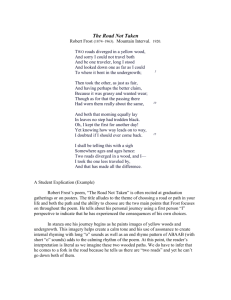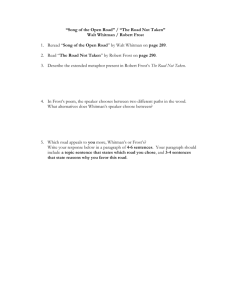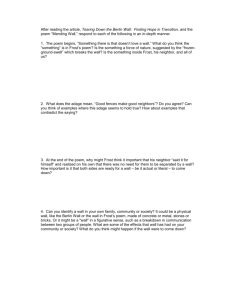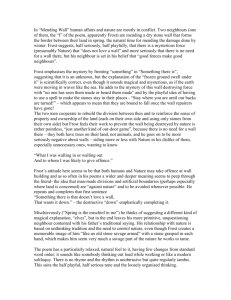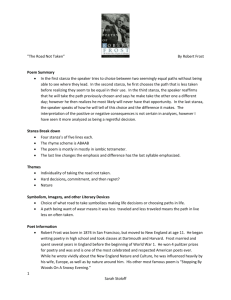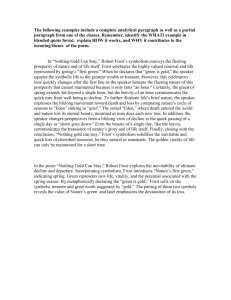Modernism (2) and Robet Frost
advertisement
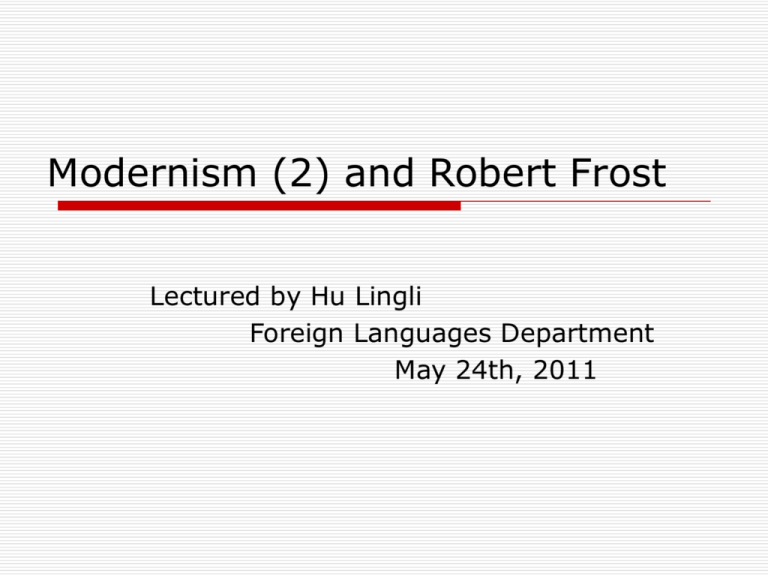
Modernism (2) and Robert Frost Lectured by Hu Lingli Foreign Languages Department May 24th, 2011 Study Objects Historical backgrounds (modernism) Brief introduction to Robert Frost Detailed analysis of “The Road Not Taken” Brief comment on “Stopping by the Woods on a Snowy Evening” Robert Frost’s research Historical Backgrounds WWI was a dividing line between the 19th century and modern America, and WWII was another dividing line separating America from the contemporary period. However, the 1920s and 1930s, blocked off from other periods in American history by a world war at either end, were very different from each other. They possessed distinguished features and produced writers of different styles. America in the 1920s This is a time of carefree(安逸的) prosperity, free from the world’s problems, bewildering social change, a feverish pursuit of pleasure, selfish frivolity(轻浮), abandonment of social customs. Industrialization and urbanization. Women’s liberation. Mass media and luxuries. A sense of disillusionment. The Lost Generation Disillusioned by the War and disgusted about the society, many intellectuals and young people fled to Europe, standing aside and writing about what they saw—the failure of communication among Americans and the failure of the American society. They believed that the American bourgeois society was hypocritical, vulgar and crude, concerning only with making money. It was a society where individual thought and individual expression were crushed. They were looking forward for a complete change. These people include Fitzgerald, Hemingway, e. e. cummings, Sinclair Lewis, Eugene O’Neill. Gertrude Stein. America in the 1930s This is a time of poverty, unemployment, bleakness, important social movements, a new social consciousness and social upheaval. Some important things happened in history included: The Crash. The collapse of the Stock Market in 1929 brought about an abrupt end to the prosperity in the previous decade. Workers were unemployed whereas the farmers were driven off the land by drought and debts. By 1933, America was close to economic collapse. America in 1930s The New Deal. Thanks to Franklin Roosevelt who launched the New Deal, improvements were seen again and a lot of changes to benefit people were discovered. The Leftists(左翼分子). The expatriates came back from Paris, taking an active part in political agitation and social improvements. They spoke on behalf of the oppressed and the suffering people, looking to Russia as an example of a better, more secure social system. It is said that people in the 1920s believed in everything, people in the 1930s believed in one thing, and people in the 1940s believed in nothing. Robert Frost (1874-1963) A poem begins in delight and ends in wisdom. My quarrel with the world is a lover’s quarrel. Biographical introduction Birth and family: was born in San Francisco, but known as a New England poet. At the age of 10, his father died of T. B. and the family carried his body to be buried in New England, and they were too poor to go back to San Francisco. Education: Frost entered Dartmouth College, but soon left; later on he tried college again at Harvard, but left at the end of two years, bearing an enduring dislike for academic convention. Then he lived by farming, at the same time writing poetry. He got T. B., and began to live in the countryside at the suggestion of a doctor. He used to say he was one and a half men—a half teacher, a half farmer, and a half poet. Personal Life: grief and loss Robert Frost's personal life was plagued with grief and loss. In 1885 when Frost was 11, his father died of tuberculosis, leaving the family with just eight dollars. Frost's mother died of cancer in 1900. In 1920, Frost had to commit his younger sister Jeanie to a mental hospital, where she died nine years later. Mental illness apparently ran in Frost's family, as both he and his mother suffered from depression, and his daughter Irma was committed to a mental hospital in 1947. Frost's wife, Elinor, also experienced bouts of depression. Elinor and Robert Frost had six children: son Elliot (1896–1904, died of cholera); daughter Lesley Frost Ballantine (1899–1983);son Carol (1902– 1940, committed suicide); daughter Irma (1903– 1967); daughter Marjorie (1905–1934, died as a result of puerperal fever after childbirth); and daughter Elinor Bettina (died just three days after her birth in 1907). Only Lesley and Irma outlived their father. Frost's wife, who had heart problems throughout her life, developed breast cancer in 1937, and died of heart failure in 1938. Continuing… Honorable things: a. By the end of his life he had become a national poet; he received honorary degrees from 44 colleges and universities and won Pulitzer Prize four times; b. the United States senate passed resolutions honoring his birthdays and when he was eightyseven he read his poetry at the inauguration of President John F. Kennedy. His Major works A boy’s will (1913) 一个男孩的意愿 North of Boston (1914) 波士顿的北部 New Hampshire (1923) Pulitzer Prize winner Collected Poems (1930) Pulitzer Prize winner A Further Range (1936) Pulitzer Prize winner A Witness Tree (1942) Pulitzer Prize winner Frost’s writing features Frost took no part in the literary movements of the 20th century. He did not experiment with form, as many poets did in the 1920s, but used traditional forms such as the blank verse, plain language, and a graceful style. (Wordsworthian style ) He used symbols from everyday country life to express his deep ideas. As a whole, Frost’s art is an act of clarification, which, without simplifying the truth, renders it in some degree accessible to everyone. (Emerson) Frost’s writing features He is highly regarded for his realistic depictions of rural life and his command of American colloquial speech. His work frequently employed settings from rural life in New England in the early twentieth century, using them to examine complex social and philosophical themes. Frost’s main ideas his poetry reflects the fragmentation of modern experience and alienation among modern men. The world of Frost can be appalling and terrifying. His concern with nature reflected deep moral uncertainties. He understood the terror and tragedy, and at the same time, its beauty. The Road Not Taken (Stanza 1) Two roads diverged in a yellow wood, And sorry I could not travel both And be one traveler, long I stood And looked down one as far as I could To where it bent in the undergrowth; The Road Not Taken (stanza 2) Then took the other, as just as fair, And having perhaps the better claim Because it was grassy and wanted wear, Though as for that the passing there Had worn them really about the same, The Road Not Taken (stanza 3) And both that morning equally lay In leaves no step had trodden black. Oh, I marked the first for another day! Yet knowing how way leads on to way I doubted if I should ever come back. The Road Not Taken (stanza 4) I shall be telling this with a sigh Somewhere ages and ages hence: Two roads diverged in a wood, and I, I took the one less traveled by, And that has made all the difference. How did this poem come about? Frost claims that he wrote this poem about his friend Edward Thomas, with whom he had walked many times in the woods near London. Frost has said that while walking they would come to different paths and after choosing one, Thomas would always felt wondering what they might have missed by not taking the other path. Discussion questions If there are two roads before you, will you choose the more-trodden road or the less-trodden road? Why? What do the roads symbolize? Does the speaker regret making such a choice? Why is the poem entitled “The Road Not Taken”? Do you think the message in the poem is also meaning in your life experience? Study objects Examine the poetic form Describe the similarities and differences of these two roads. Which one does the speaker take? How do you understand the word “sigh”?Is it a kind of nostalgic relief or regret? What might the two roads stand for in the speaker’s mind? What is the theme of this poem? Poetic form “The Road Not Taken” consists of four stanzas of five lines. The rhyme scheme is ABAAB; the rhymes are strict and masculine, with the notable exception of the last line (we do not usually stress the -ence of difference). There are four stressed syllables per line, varying on an iambic tetrameter base. Understanding Stanza 1 the dilemma he encountered. He had been out walking the woods and came to a fork of two roads. Then, he stood looking as far down each one as he could see, pondering which route to go. The roads and the fork of two roads are metaphorical and symbolic. Understanding stanza 2 Which road did the speaker take? Describe the similarities and differences of these two roads. Which one does the speaker take? Similarities: both of the roads are attractive(fair) Differences: one is quiet and grassy, lesstraveled; the other is trodden by many people and flat Understanding stanza 3 In the third stanza, the poet continued to cogitate upon the differences between the two roads. Greed as another nature of mankind, he wondered maybe one day he could come back and try the other one. However, reason made him doubt he would be able to, for in life one thing leads to another and time is limited. Once he chose to be a poet, hardly can he be a farmer again. Life would push him to carry on what he had chosen. Understanding stanza 4 How do you understand the word “sigh”?Is it a kind of nostalgic relief or regret? The word “sigh” is a tricky word. Because sigh can be interpreted into nostalgic relief or regret. If it is the relief sigh, then the difference means the speaker feels glad with the road he took. If it is the regret sigh, then the difference would not be good. Hence, sigh is ambigous here for the speaker is not showing whether his choice is right or wrong. What might the two roads stand for? In the speaker’s mind, the two roads not only refer to the real roads he has to take more sigificantly, it means two different ways of life when one hesitates before the life’s crossroad. It also suggests that he doesn’t follow suit but employs the traditional pattern in spite of the influence of modernist innovation. Themes Choice is inevitable but you never know the outcome of your choice until you come to the end. No right or wrong, persisting with your choice is most important. Different choices only mean different life experiences. Be brave to choose and keep going on. Epigrams concerning the topic of “road” 条条道路通罗马。 希望是本无所谓有,无所谓无的。这正如地上 的路,其实地上本没有路,走的人多了,也便 成了路。 走自己的路让别人去说吧! 路遥知马力,日久见人心。 书山有路勤为径,学海无涯苦作舟。 山重水复疑无路,柳暗花明又一村。 路漫漫其修远兮,吾将上下而求索。 Suggestions for reading “Stopping by Woods on a Snowy Evening” Identify the poetic form Notice the abundant imagery (visual, auditory, tactile) Symbolism (woods) The poet’s moral concern (temptation, obligation) Study Questions What is the subject matter of the poem? What is the function of the horse? What is the speaker’s attitude towards the woods? Why does the speaker repeat “And miles to go before I sleep”? What musical devices does the poem contain? (The poem consists of four (almost) identically constructed stanzas. Each line is iambic, with four stressed syllable) Comment The basic conflict in the poem, resolved in the last stanza, is between an attraction toward the woods and the pull of responsibility outside of the woods. What do woods represent? Something good? Something bad? Woods are sometimes a symbol for wildness, madness, the pre-rational, the looming irrational. But these woods do not seem particularly wild. They are someone’s woods, someone’s in particular—the owner lives in the village. But that owner is in the village on this, the darkest evening of the year—so would any sensible person be. That is where the division seems to lie, between the village (or “society,” “civilization,” “duty,” “sensibility,” “responsibility”) and the woods (that which is beyond the borders of the village and all it represents). If the woods are not particularly wicked, they still possess the seed of the irrational; and they are, at night, dark—with all the varied connotations of darkness. Robert Frost’s Research The interpretations of Frost’s major poems: The Road Not Taken, Stopping by the Woods on a Snowy Evening (themes, artistic features) Ecological view reflected in Frost’s poetry Frost’s philosophical ideas exemplified in Frost’s poetry Future researches: comparative studies (Robert Frost & Ezra Pound, T.S. Eliot, Ernest Hemingway, Robert Burns) Homework A Self-study of “Mending the Wall” a. What does the wall symbolize? b. Do you think this poem has practical guiding significance in your/our life? Thank you for your attention!

